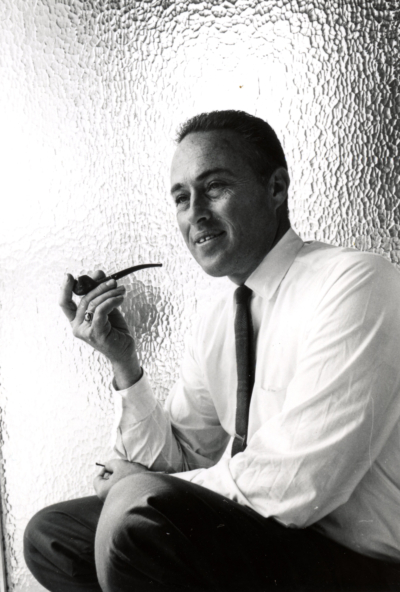By Keith York
 Over several years of visiting with retired architect Loch Crane at his La Jolla home, I was treated to stories of his time with Frank Lloyd Wright, tales of his service in World War II, and meetings with many of the members of his extended family. Loch was born in 1922 in Pittsburgh, Pennsylvania, and I knew him only in his last 15 years with us – at a time when his family, clients, neighbors, and friends had known him much longer and more intimately. Perhaps my naïve questions and solicitations for details about his amazing stories reawakened some of his spirits as we travelled his memories together. He lived a fascinating, deeply joyous life as a passionate architect, a devoted husband, a pilot, a skilled boat-builder, and an inspirational sailing guide.
Over several years of visiting with retired architect Loch Crane at his La Jolla home, I was treated to stories of his time with Frank Lloyd Wright, tales of his service in World War II, and meetings with many of the members of his extended family. Loch was born in 1922 in Pittsburgh, Pennsylvania, and I knew him only in his last 15 years with us – at a time when his family, clients, neighbors, and friends had known him much longer and more intimately. Perhaps my naïve questions and solicitations for details about his amazing stories reawakened some of his spirits as we travelled his memories together. He lived a fascinating, deeply joyous life as a passionate architect, a devoted husband, a pilot, a skilled boat-builder, and an inspirational sailing guide.
Among the many stories Loch shared with me was how his mom handed him the January 17, 1938, issue of Time Magazine, featuring Frank Lloyd Wright on the cover. As he gazed at the magazine, Edith Crane said, “…this is who you will go work for.” He was understandably skeptical of his mother’s words. But after a number of high school drafting classes, and a short stint in the offices of San Diego architects Richard Requa and William Templeton Johnson (alongside Robert Mosher), he was hopeful. During the summer after he graduated from high school, on August 26, 1940, Edith wrote Frank Lloyd Wright requesting “…information regarding your course of instruction.” This and several other letters between the Cranes and Wright are held by the Getty Research Institute – documenting his (and many other young budding architects’) pursuit of a Taliesin Fellowship with the great architect.
Loch and his mother packed up her Ford Model A and left Point Loma to drive to Taliesin West outside of Scottsdale. They arrived in Arizona in March 1941 – Mrs. Crane brandishing a $1,000 check for the fellowship tuition, and the younger Crane armed with completed drawings from Templeton Johnson’s office. Wright accepted him for the fellowship. After returning to Point Loma briefly, Crane returned to Taliesin in April to begin the long caravan road trip to Taliesin in Spring Green, Wisconsin, for the spring and summer months with Wright and other students.
Later that year Loch Crane made a life-changing decision. While he was working in the Taliesin drafting room, news came over the Fisher radio that Pearl Harbor had been bombed. The date was December 7, 1941, and Crane was only months into his fellowship. Despite encouragement from Mr. Wright that his fellows embrace pacifism, Crane and a few others wanted to fight for their country. Crane signed up for the Army Air Corps and terminated his Taliesin fellowship in April 1942.
Loch married Clare Bloodgood (1926-2011), whom he met while at Taliesin, in 1944, and returned to combat. Following his service flying B-25 bombers, the young pilot stayed in Japan through 1946, teaching and overseeing construction efforts as a Major – Director of Installations. While off duty, Loch spent his time photographing, drawing, and researching Japanese architecture. Many of these photographs he would later present to Mr. Wright and his students – all of whom appreciated Japanese culture.
He returned to San Diego in late 1946 and established his first office as a Building Designer. By 1948, he built his first “Expandable Home” on Udall Street in Point Loma – testing the concept for his own family. The concept house was intended to be built in stages – expanding as one’s family grew. What was supposed to start out as a one-bedroom house was expanded immediately, as the Cranes expected the birth of their son.
The young veteran returned to active duty during the Korean War – after which he returned to private practice in San Diego. He began to pick up work immediately as a building designer – building small professional buildings and warehouses for Bob Golden and Gene Trepte, as well as a few homes for private clients. Soon, the City of San Diego began to pressure him about the volume of unlicensed work he was producing. Taking advantage of the GI Bill, he secured his degree in architecture from USC. Of this time, he later wrote:
My limited capability became apparent and I thus entered the College of Architecture at USC for the academic background to supplement my practical experience … to serve the public at a level where I can “feel” the needs and aspirations of the individual yet adapt that same individual into harmonious and mutual advantageous relationships with the larger community….
Established as Loch Crane, AIA Architect, the office would grow and change over the years – quickly moving from small private residences to large-scale buildings for developers, commercial clients, and the military.
Whether he was designing buildings, flying airplanes, or building boats, Loch expressed his unique connection with the natural world – a continued influence from Mr. Wright that moved him through life and his professional career. “Building with one’s own hands” was, according to Loch, “the essence of life.” Understanding the relationship between indoors and outdoors, building something useful, and creating small environments in harmony with the larger environment, were the essence of his search for connection and belonging. He pursued his profession with vigor, often outside the conventions of AIA meetings and conferences, as well as city politics. To this day I recall his guiding statement, “I want to turn to nature for my sense of belonging.”
On the eve of opening my exhibition, Frank Lloyd Wright’s Legacy in San Diego, I interviewed Loch one last time. As Alzheimer’s disease debilitated my friend, I was constantly amazed by his recall of the 1940s and ‘50s – and that was evidenced in our last conversation in August of 2015. The conversation, as always, was inspiring. He offered this summation of his approach to architecture:
I loved my clients. I really enjoyed them. You had to realize which direction … which game both sides wanted to play. You have to draw … what the site would allow and what they wanted and it was a beautiful challenge from one job to another.
Note: Image, Courtesy of Keith York
